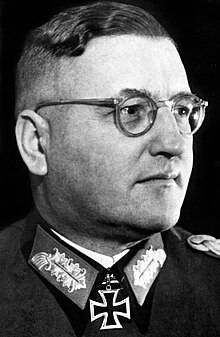This articleneeds additional citations forverification.(October 2012) |
Ernst Hermann August Theodor Busse(15 December 1897 – 21 October 1986)[1]was aGermanofficer duringWorld War IandWorld War II.[2]
Theodor Busse | |
|---|---|
 Busse asGeneral der Infanterie | |
| Born | 15 December 1897 Frankfurt an der Oder,German Empire |
| Died | 21 October 1986(aged 88) Wallerstein,West Germany |
| Allegiance | |
| Service | |
| Rank | General der Infanterie |
| Unit | Heeresgruppe Süd |
| Battles / wars | World War I
World War II |
| Awards | Knight's Cross of the Iron Cross Federal Cross of Merit |
Early life and career
editBusse, a native ofFrankfurt (Oder),joined the ImperialGerman Armyas an officer cadet in 1915 and was commissioned in February 1917. He also won the Knight's Cross with Swords of the Hohenzollern Order. After the armistice, he was accepted as one of 2,000 officers into the newReichswehrin which he steadily rose in rank.
World War II
editBusse was a General Staff officer in April 1939 and prepared a training program that was approved by the Chief of the General Staff in August and covered a period from 1 October 1939 to 30 September 1940. Between 1940 and1942,he served as the Chief of Operations to General (laterField Marshal)Erich von Mansteinin the11th Armyon theEastern Front.He remained serving on von Manstein's staff from 1942 to 1943 as Chief of Operations ofArmy Group Donand then from 1943 to 1944 he was Chief of Staff ofArmy Group South,both on the Eastern Front. Serving with Army Group South, he was awarded theKnight's Cross of the Iron Crosson 30 January 1944. He spent a short time in reserve and was then appointed General Officer CommandingGerman 121st Infantry Division.In July 1944, he commandedI Army Corps.
While Busse took command of the9th Armyon 21 January 1945, his appointment was never confirmed. It would appear that it was customary for commanders of formations of the status of an Army and higher to be on six months probation before their final appointments as Commanders-in-Chief. Germany surrendered unconditionally before Busse's probationary period had expired.[3]
During the last five months of the war, Busse commanded the9th Army,which had become part ofArmy Group Vistula.As the Soviets continued to advance into Germany, he fought to protect the German capital. Specifically, Busse commanded the 9th Army during theBattle of Seelow Heightsand theBattle of the Oder-Neisse.In April 1945, during theBattle of Berlin,Busse's Ninth Army was cut off from the armies on its flanks and almost encircled by Soviet Forces. GeneralGotthard Heinricitried to convince Busse to withdraw several times, but Busse refused even to consider withdrawal unless a specific command arrived from theFührer.Eventually Busse's Ninth Army was driven into a pocket in the Spree Forest south of the Seelow Heights and west of Frankfurt, where it became fully encircled by two prongs of the massive Soviet assault on Berlin. In the ever-shrinking pocket, Busse's forces were all but annihilated in what is known as theBattle of Halbe,but remnants ultimately managed to break through to the west to link up with GeneralWalther Wenck’s12th Armysouth ofBeelitzand then to withdraw west to the Elbe, cross the partially-destroyed bridge atTangermündeand surrender to American forces between May 4 and 7.
Postwar
editBetween 1945 and 1947, Busse was aprisoner-of-war.[3]After the war Busse wasWest Germany's director of civil defense, and he wrote and edited a number of works on the military history of World War II.
Awards and decorations
edit- Ehrenkreuz für Frontkämpferon the 5th of December 1934
- Clasp to the Iron Cross
- 2nd Class on 27 May 1940
- 1st Class on 30 May 1940
- German Crossin Gold on 24 May 1942 asOberstim Generalstabin AOK 11[4]
- Knight's Cross of the Iron Cross(N 2611) on 30 January 1944 as Generalleutnant and Chief of the Generalstab of Heeresgruppe Süd[5][6]
- Knight Commander's Cross of the Order of Merit of the Federal Republic of Germany(25 January 1966)
Books by Busse
edit- "Kursk: The German View" by Steven H. Newton. The first part of the book goes to a new translation of a study ofOperation Citadel(the great tank battle of Kursk) edited by General Theodor Busse, which offers the perspectives of key tank, infantry, and air commanders.
References
editCitations
edit- ^"0131786 - THEODOR BUSSE (1897-1986). Ernst Hermann August Theodor Busse. German officer during World War I and World War II. Photographed wearing the Knight's Cross, 1944".Granger.Retrieved2021-02-02.
- ^"World War 2 Generals – A thru B / Weltkrieg 2 Generäle – A durch B".Historical Society of German Military History - Historische Gesellschaft der deutschen Militärgeschichte.2016-12-31.Retrieved2021-02-02.
- ^abNuremberg Trial Proceedings Volume 42. SeeBibliography
- ^Patzwall & Scherzer 2001, p. 71.
- ^Fellgiebel 2000, p. 151.
- ^Scherzer 2007, p. 256.
Bibliography
edit- Fellgiebel, Walther-Peer (2000) [1986].Die Träger des Ritterkreuzes des Eisernen Kreuzes 1939–1945 — Die Inhaber der höchsten Auszeichnung des Zweiten Weltkrieges aller Wehrmachtteile[The Bearers of the Knight's Cross of the Iron Cross 1939–1945 — The Owners of the Highest Award of the Second World War of all Wehrmacht Branches] (in German). Friedberg, Germany: Podzun-Pallas.ISBN978-3-7909-0284-6.
- Patzwall, Klaus D.; Scherzer, Veit (2001).Das Deutsche Kreuz 1941 – 1945 Geschichte und Inhaber Band II[The German Cross 1941 – 1945 History and Recipients Volume 2] (in German). Norderstedt, Germany: Verlag Klaus D. Patzwall.ISBN978-3-931533-45-8.
- Scherzer, Veit (2007).Die Ritterkreuzträger 1939–1945 Die Inhaber des Ritterkreuzes des Eisernen Kreuzes 1939 von Heer, Luftwaffe, Kriegsmarine, Waffen-SS, Volkssturm sowie mit Deutschland verbündeter Streitkräfte nach den Unterlagen des Bundesarchives[The Knight's Cross Bearers 1939–1945 The Holders of the Knight's Cross of the Iron Cross 1939 by Army, Air Force, Navy, Waffen-SS, Volkssturm and Allied Forces with Germany According to the Documents of the Federal Archives] (in German). Jena, Germany: Scherzers Militaer-Verlag.ISBN978-3-938845-17-2.